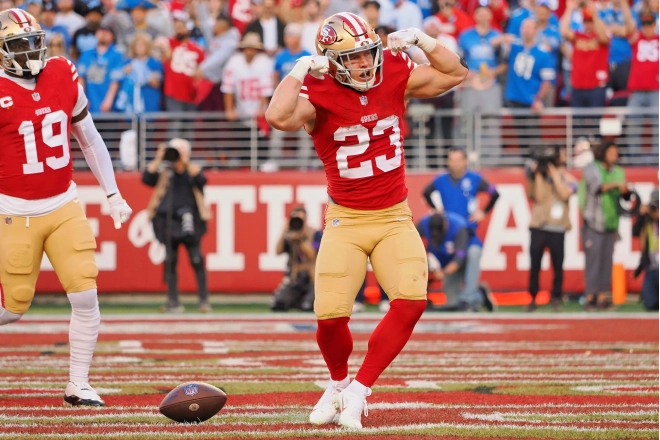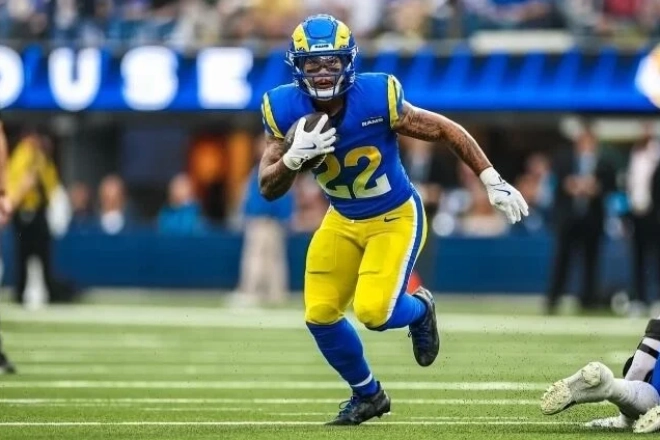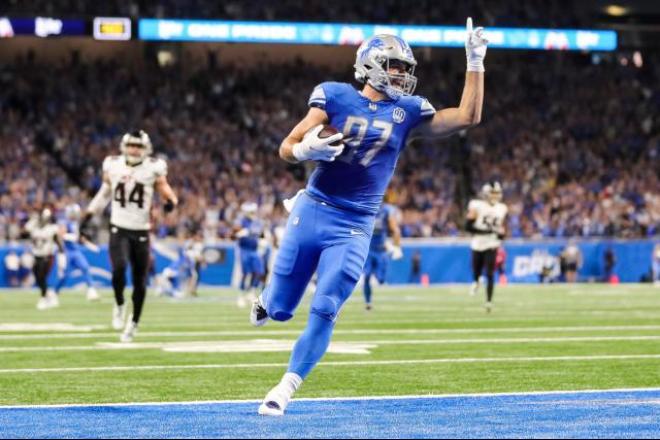Introduction of the Study
This article provides a statistical analysis of tight end performance, examining their success in relation to their average draft position (ADP) in dynasty rookie drafts and their years of experience in the NFL. It is the 4th part of a five part series, which includes:
- How To Add A QB1 To Your Dynasty Team - '24
- How To Add An RB1 To Your Dynasty Team - '24
- How To Add A WR1 To Your Dynasty Team - '24
I consistently do these for my own dynasty fantasy football team, and have learned a lot, as my team regularly makes the playoffs. As proof, last year my team had the highest total fantasy points and went to the championship game. Additionally, I have a strategy for managing my draft picks such that going into the 2024 draft, I am holding picks: 1.06, 1.09, 2.02, 2.04, 2.11, 3.02, 3.04, 3.07, 3.11 and 3.12.
This past season my team was strong at QB, WR and TE, and my TE's include both Evan Engram and Dalton Kincaid. With a weaker running back corps, I often started two tight ends, leading to the highest total fantasy points in the league. The strength of my tight end position was crucial to my team's overall success.
The starting lineup in our PPR league requires 1 QB, 2 RBs, 3 WRs, 1 TE, 1 Flex (RB, WR or TE), 1 K and 1 DST.
My roster heading into this season is:
- QB: Jalen Hurts and Anthony Richardson
- RB: James Cook, Jerome Ford, Brian Robinson and Tyler Allgeier
- WR: Tyreek Hill, Deebo Samuel, Brandin Cooks, Michael Wilson and Kyle Phillips
- TE: Evan Engram, Dalton Kincaid
- K: Cairo Santos
My greatest need is at WR, as I traded Mike Evans in the off-season for an offer too good to refuse: a high first-round pick and two high second-round picks. Moving forward, I plan to convert those into future 1sts. While this is a good draft for me secure additional talent at the WR position, I still need to determine how to best strengthen my RB corps.
With that said, I would also like more depth at TE. Brock Bowers is projected as a top NFL talent and has an ADP in the first round. If Bowers fell to me at 1.06 and was the best value on the board, I might consider taking him even though I already have two very good TEs. However, there are other ways to add depth without using my 1.06 pick, and this study will explore not only the incoming rookie TEs but also other players at the position that could be available via trade.
Draft day is magical, with rookie hype at its peak. Even in the 2nd and 3rd rounds, many managers have favorite players they’re eager to draft based on sleeper value they've read about. If you can resist the rookie hype, trading for veteran players during the draft is highly advantageous. However, for this strategy to work, be sure to do your homework and know which veterans you want to target before your draft begins.
This analysis will help guide you so you can see the real value of draft picks and make much more calculated decisions regarding bolstering your TE corps.
Historical ADP Information
Based on historical ADP information, this is where tight ends were drafted over the last ten years:
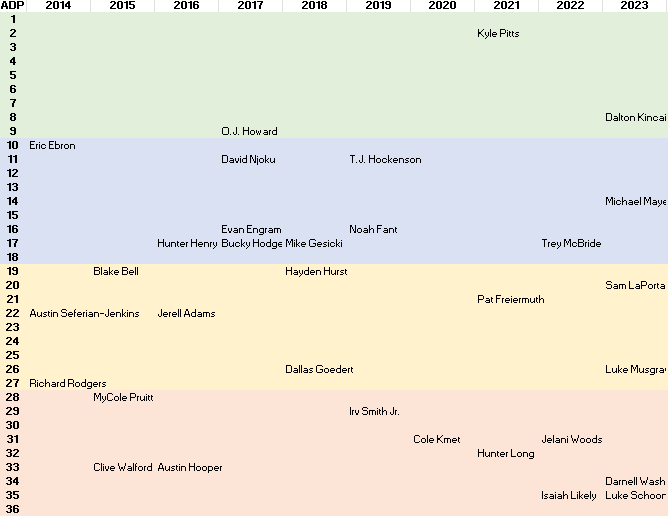
Here are additional fantasy relevant TEs that were not taken in the first three rounds: George Kittle, Mark Andrews, Dalton Schultz, Darren Waller, Tyler Higbee, Logan Thomas, Tonyan Robert, Taysom Hill, Dawson Knox, Juwan Johnson, Jake Ferguson.
What about Travis Kelce and Rob Gronkowski? They are not part of this study because they entered the NFL league prior to 2014 and I don't have the ADP data any further back. However, they are the prototypical example of what we are looking for - a top-6 TE that lasts a decade - and are proof that this type of TE can exist, even though they are rare.
In last year's TE study I concluded that there was a lot of randomness in the performance of TEs, where they could lurk below the radar for years and then pop up as a TE1, seemingly out of nowhere. After adding the 2023 data and looking at it again, I don't see as much of the randomness as I saw last year. Rather I am seeing a trend that the development time for a TE to be a top receiving target is longer than other positions.
Success Rate vs Years of Experience
The next step in my analysis is to see how these players have panned out since being drafted. In my analyses of the different position, I have valued the top 12 QBs, the top 24 RBs and top 36 WRs while basing it on my league's starting lineup requirements. For TEs, I value just the top 12, with a value of 1 for a top-6 and a value of 0.5 for 7th through 12th.
I then took the integral of their results and got this chart:
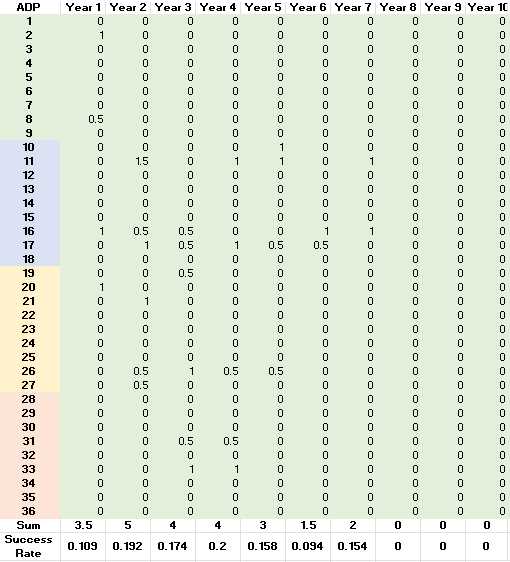
Next I put this information into graphical form:
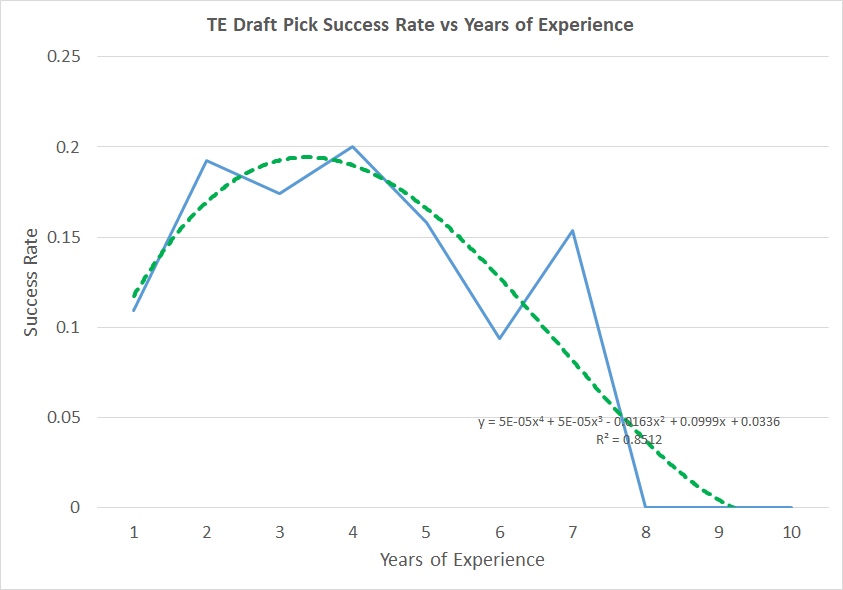
As we can see from this chart, of all the TEs drafted in the last 10 years within the first three rounds, their 4th year in the league seems to result in peak performance.
Draft picks are a dynasty team asset that always rise in value. If we want to maximize the value of our team, we want to use our draft picks efficiently. One way to do that is to trade draft picks forward and up. For example, on draft day I can often trade a high 2nd round pick for a future 1st round pick, or a mid 2nd round pick for two 2nds, or a 2nd and a 3rd. These types of trades are the best way to increase the value of your team because they are certain to increase in value over time.
While trading for future draft capital is good, the second best way to improve your team overall is to trade your picks for players that are most likely to rise in value. With respect to TEs, generally speaking this would include rookies, 2nd year, and 3rd year players. During the season, if we find ourselves in dire need of tight end firepower, we can consider trading for a veteran player whose value is on the decline, as we have a substantial collection of draft picks that we can use for such trades. However, when it comes to the draft itself, our primary focus should be on acquiring assets that we anticipate will appreciate in value, such as future picks, or on young players with the greatest potential for growth.
Here is my quick analysis of the TEs of interest that have entered the NFL in the last three years:
2023
- Dalton Kincaid: Kincaid was the 11th overall TE in his rookie season and looks to be on the rise as the Bills lost their two top receivers, Stefon Diggs and Gabe Davis, in the off-season. Kincaid already has a high 1st round pick consensus value. He is already on my roster, but you would be doing very well if you could sneak him on your roster for a high 2nd round pick
- Michael Mayer: The Raiders drafted Brock Bowers, so Mayer has been pushed down the depth chart. Double tight-end sets are decreasing in the NFL, but a Mayer/Bowers double tight-end set would be interesting. Mayer ranked 31st among TEs last year. I am not interested in Mayer for 2024.
- Sam LaPorta: LaPorta was the overall top TE in 2024 in his rookie year. His consensus value is a high 1st round pick. Will he be the next Travis Kelce? Maybe, but I am not interested because I would need to pay full price for him.
- Luke Musgrave: Musgrave ranked 28th in 2023, before he lacerated his kidney and missed six games. He was on a pace of being 18th overall before his injury. Musgrave is a very athletic, 6'6", 250+ lb tight end that can dominate over the middle of the field. Will he become a favorite target of Jordan Love in 2024? He certainly could land in TE1 territory, and his consensus value is a high 3rd pick. I might be interested in Musgrave for a low 3rd round pick.
- Darnell Washington: Washington is behind Pat Freiermuth on the Steelers depth chart and ranked 81st overall last season. Still, he played in 43% of snaps in mostly a blocking role. Commensurate with his size (6'6", 264 lbs), he has shown potential as a possession and red-zone receiver. I would expect his receiving skills to improve and have more receiving opportunities in 2024, but I am not interested.
- Luke Schoonmaker: "Schoon" had an underwhelming rookie season is injured for OTAs for the 2nd year in a row. Yet, he did play in 31% of offensive snaps last year, and if he can get and stay healthy it's reasonable to expect his role to increase in 2024. However, I am currently not interested.
2022
- Trey McBride: 50, 8, 7, From Week 6 to Week 17, are the TEs that ranked from 2nd through 6th scored from 153.6 to 153.2. Even though in that stretch of the season McBride was the 6th TE, he narrowly missed being the 2nd TE of that group by only 0.4 fantasy points. This offseason, the Cardinals bolstered their receiving corps by adding Marvin Harrison Jr. However, this addition might primarily benefit McBride, as he currently faces limited competition for targets. His consensus value is a high 1st round pick. I would certainly be interested in him if I could snag him for a 2nd rounder.
- Jelani Woods: I had Woods on my roster the last two years believing he has very high potential. He is the perfect athletic mix for a TE and when healthy has shown flashes of greatness. Sadly, I let him go for a 3rd round pick in order to make room on my roster for the draft. Currently, Woods has been working through his hamstring issues and is doing great in OTAs. Even though the Colts have a crowded TE room, I believe Woods is by far their best TE and that he has TE1 potential if he can stay healthy. I will probably kick myself for letting him go. I would certainly be interested in him for a late 3rd pick if I could get him back, but I am confident the owner that has him now won't let him go for that.
- Isaiah Likely: Likely was the 25th TE in 2023 and is behind Mark Andrews on the depth chart. When Andrews was injured for eight games last season, Likely played well. Now the Ravens have acquired Derrick Henry and could be the number 1 rushing team again in 2024. This could cause the Ravens to go with more two-TE sets and Likely could get more targets as a play-action option. However, if Andrews is healthy for the full season, he will most likely (pun-pun) see limited play time. For that reason, I am not interested.
- Jake Ferguson: Ferguson ranked 9th last year and seems poised to do the same this year as one of Dak Prescott's dependable targets. If I could get him for a 3rd round pick, he would add some nice depth to my TE corps.
2021
- Kyle Pitts: Pitts had an incredible rookie year, being only the 2nd rookie TE to eclipse 1,000 receiving yards (Mike Ditka was the first). In 2022, Pitts faced an injury, and in 2023, appeared to still be dealing with lingering health issues. Compounding his challenges, he's had to adapt to working with a rotating lineup of quarterbacks in Atlanta, including Matt Ryan during his rookie season, then Marcus Mariota, Desmond Ridder, and Taylor Heinicke. This year brings further changes as the Falcons have a new head coach and quarterback in Kirk Cousins. While Pitts is in the process of relearning the offense alongside the rest of the team, he's confirmed he's fully healthy and seems to be developing promising chemistry with his new QB. He ranked 14th last year and has a 1st round pick consensus value. If I could get Pitts for a 2nd round pick, I might be interested.
- Pat Freiermuth: Freiermuth had a promising rookie season with Ben Roethlisberger under center, but hasn't been much of a focal point for the Steelers since, ranking 21st in 2023. This year Arthur Smith has taken over as offensive coordinator and has a history of heavily involving tight ends. Freiermuth could find himself playing a major role on the Steelers offense in 2024. His consensus value is a 2nd round pick, but I am not interested. If I spend a 3rd round pick on a TE, I want to believe he has high top-6 TE potential, or at least a solid TE1 with a high floor, and I don't feel Freiermuth is there.
- Hunter Long: He ranked 119th last year and I can't find any news on him. No thanks.
To summarize, here is what I might be willing to pay for the above players:
- 1st round pick: Sam LaPorta, Brock Bowers
- 2nd round pick: Dalton Kincaid, Trey McBride, Kyle Pitts
- 3rd round pick: Luke Musgrave, Jelani Woods, Jake Ferguson
- Not worth the space on my roster: Michael Mayer, Darnell Washington, Luke Schoonmaker, Isaiah Likely, Pat Freiermuth, Hunter Long
I realize that these suggested offers during dynasty rookie drafts are below market value for the above mentioned players. However, that's exactly the point. You are trying to leverage frequent over valuation of rookies and dynasty draft picks due to the overwhelming rookie hype on draft day. When you know how to leverage that hype, you can find lots of opportunity, as the draft now becomes a once-in-a-season bargain shopping event. Even if you send out a trade offer and are rejected, you've now sowed seeds with which to potentially open up future trade discussions.
TEs are the least drafted position in dynasty leagues, with Kyle Pitts as the only TE drafted with a top-6 pick in the last 10 years. During my brief time in a dynasty super-flex league, fellow owners often joked about tight ends being the kickers of super-flex. However, I disagree with this assessment, as I've noticed a shift in the perception of top-tier tight ends over the years. Players like Kyle Pitts, Dalton Kincaid, and Brock Bowers have consistently held ADPs within the top 8 picks over the last four seasons, and this stands in stark contrast to the six years prior, where no tight ends were drafted with such high ADPs in dynasty leagues. Therefore, don't under-estimate the value of having a solid TE corps. Again, my team had the highest fantasy points last season, and I started 2-TE starting lineups in Weeks 8, 10, 11, 12 and 15 after I became confident in the rookie Kincaid.
Since I don't have ADP data going back more than 10 years or ADP rankings greater than 36, the above chart does not include the performance of players such as Rob Gronkowski, Travis Kelce, Mark Andrews, George Kittle, Tyler Higbee, Darren Waller. While this analysis is informative, it overlooks the performances of several forgettable tight ends, and including these less prominent players would be essential for a comprehensive calculation of success rates among the notable ones.
Success Rate vs Average Draft Position
Now, let's finish breaking down draft value versus ADP.
This is a break down of success rate by round:
- 1st: 21.2%
- 2nd: 13.7%
- 3rd: 9.8%
With the QBs we found a 2nd band of success in the 2.07 to 3.03 range, and this is the reason for the color bands in the charts above - to break down the analysis into every 9 picks rather than each round. Here is the same break down with TEs:
- 1-9: 13.6%
- 10-18: 22.4%
- 19-27: 10.2%
- 28-36: 6.8%
Despite this, we currently only have data for three players that had a top-9 ADP in the last 10 years: O.J. Howard, Kyle Pitts and Dalton Kincaid. Therefore, this isn't really enough to be statistically significant. I would stay with just the rates per round (rather than per every 9 picks) and similar to WRs, TEs drafted in round 1 are about twice as successful as TEs drafted in round 3.
Wrap-Up
My TE corps going into this draft is Evan Engram and Dalton Kincaid, and I would like one more TE to round out the position. I have greater needs at WR and RB, but if Brock Bowers with a current ADP of 1.04 is available at 1.06 I might consider him depending on who else is on the board. I am, however, more likely to try to trade for a TE in the bottom half of the draft. I might try to get Trey McBride or Kyle Pitts with my 2.11 pick or Luke Musgrave or Jake Ferguson with my 3.07, as any one of them would make a nice compliment to Engram and Kincaid.
In my next article, I plan to combine all the results of the four positions to put together a comprehensive 3-round rookie draft strategy, including the actual relative value for each pick from 1.01 to 3.12. I am excited to find out for myself what the results will be and to finally lock down my draft strategy for my league's dynasty rookie draft, scheduled to start at 6 am on June 8th.
If you found this article helpful, here are some other resources you should consider checking out:
Dynasty Draft Strategy: A Tale of Ten Trades
My Dynasty FF Team Needs An RB1
How to Win Your Dynasty League


